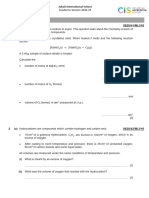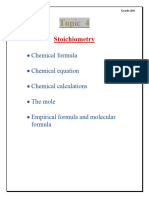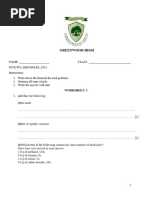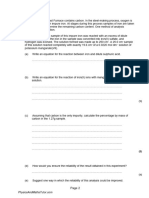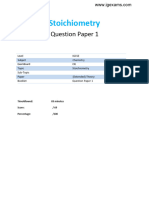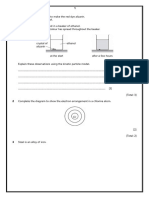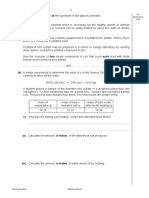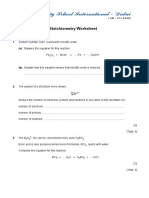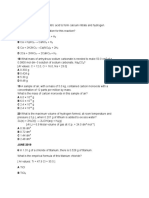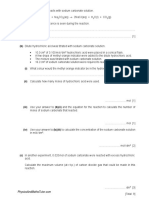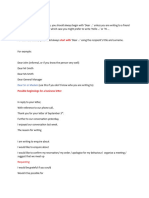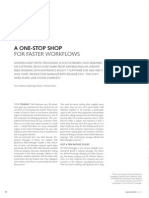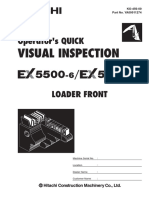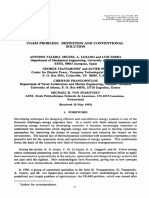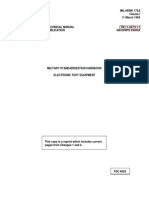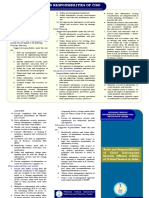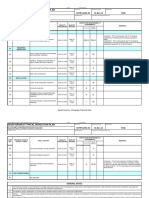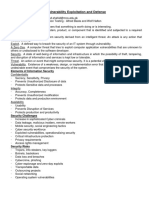Stiochem
Stiochem
Uploaded by
Zaps ClapsCopyright:
Available Formats
Stiochem
Stiochem
Uploaded by
Zaps ClapsCopyright
Available Formats
Share this document
Did you find this document useful?
Is this content inappropriate?
Copyright:
Available Formats
Stiochem
Stiochem
Uploaded by
Zaps ClapsCopyright:
Available Formats
12
7 Calcium chloride can be made by reacting calcium carbonate with hydrochloric acid.
CaCO3(s) + 2HCl (aq) → CaCl 2(aq) + H2O(l) + CO2(g)
An excess of calcium carbonate was added to 50.0 cm3 of 0.500 mol / dm3 hydrochloric acid. The
solution was filtered to remove the excess calcium carbonate.
(a) How many moles of HCl were used in this reaction?
..................................... mol [2]
(b) Deduce the number of moles of carbon dioxide gas made in this reaction.
..................................... mol [1]
(c) Calculate the mass of carbon dioxide made in this reaction.
........................................ g [2]
(d) Calculate the volume, in dm3, of carbon dioxide made in this reaction at room temperature and
pressure (r.t.p.).
.................................... dm3 [1]
[Total: 6]
© UCLES 2016 0620/41/O/N/16
7
5 Chlorine, bromine and iodine are halogens.
(a) Chlorine can be made in the laboratory by heating manganese(IV) oxide with concentrated
hydrochloric acid.
MnO2(s) + 4HCl (aq) → MnCl 2(aq) + 2H2O(l) + Cl 2(g)
Calculate the volume of 8.00 mol / dm3 HCl (aq) needed to react with 3.48 g of MnO2.
• moles of MnO2 used
................................ mol
• moles of HCl needed
................................ mol
• volume of HCl needed
................................ cm3
[4]
(b) A student bubbled chlorine gas into a test-tube containing aqueous potassium bromide.
(i) Describe the colour change seen in the test-tube.
from ............................................................... to ...............................................................
[2]
(ii) Complete the ionic equation for this reaction.
Include state symbols.
Cl 2(g) + ......Br –(aq) → ................ + ................
[3]
© UCLES 2016 0620/42/O/N/16 [Turn over
9
(e) Iodine forms an oxide which has the composition by mass: I, 76.0%; O, 24.0%.
(i) Use this information to determine the empirical formula of this oxide of iodine.
empirical formula ................................. [3]
(ii) The oxide of iodine in (e)(i) dissolves in water.
Predict and explain the effect of adding Universal Indicator to an aqueous solution of this
oxide of iodine.
effect on Universal Indicator ...............................................................................................
explanation .........................................................................................................................
[2]
[Total: 21]
© UCLES 2016 0620/42/O/N/16 [Turn over
11
(b) (i) 5.95 g of cobalt(II) carbonate were added to 40 cm3 of hydrochloric acid, concentration
2.0 mol / dm3.
Calculate the maximum yield of cobalt(II) chloride-6-water and show that the cobalt(II)
carbonate was in excess.
CoCO3 + 2HCl → CoCl2 + CO2 + H2O
CoCl2 + 6H2O → CoCl2.6H2O
maximum yield:
number of moles of HCl used = ………………………………………………...…..…….
number of moles of CoCl2 formed = ……………………………………………..….……
number of moles of CoCl2.6H2O formed = ………………………………………..…..…
mass of one mole of CoCl2.6H2O = 238 g
maximum yield of CoCl2.6H2O = …………………………………………………..…..… g
to show that cobalt(II) carbonate is in excess:
number of moles of HCl used = ……………………….……… (use your value from above)
mass of one mole of CoCO3 = 119 g
number of moles of CoCO3 in 5.95 g of cobalt(II) carbonate = ………………………… [5]
(ii) Explain how these calculations show that cobalt(II) carbonate is in excess.
[1]
[Total: 10]
© UCLES 2014 0620/04/SP/16 [Turn over
12
7 Iodine reacts with chlorine to form dark brown iodine monochloride.
I2 + Cl2 → 2ICl
This reacts with more chlorine to give yellow iodine trichloride.
An equilibrium forms between these iodine chlorides.
ICl(l) + Cl2(g) =! ICl3(s)
dark brown yellow
(a) What do you understand by the term equilibrium?
[2]
(b) When the equilibrium mixture is heated, it becomes a darker brown colour.
Suggest if the reverse reaction is endothermic or exothermic. Give a reason for your choice.
[1]
(c) The pressure on the equilibrium mixture is decreased.
(i) How would this affect the position of equilibrium? Give a reason for your choice.
It would move to the
reason
[1]
(ii) Describe what you would observe.
[1]
© UCLES 2014 0620/04/SP/16
13
(d) Calculate the overall energy change for the reaction between iodine and chlorine using the
bond energy values shown.
I2 + Cl2 → 2ICl
Bond Energy / kJ per mol
I–I 151
Cl – Cl 242
I – Cl 208
Show your working.
[3]
(e) Draw a labelled energy level diagram for the reaction between iodine and chlorine using the
information in (d).
[2]
[Total: 10]
© UCLES 2014 0620/04/SP/16 [Turn over
4
3 When lead(II) nitrate is heated, two gases are given off and solid lead(II) oxide remains.
The equation for the reaction is shown.
2Pb(NO3)2(s) → 2PbO(s) + 4NO2(g) + O2(g)
(a) Calculate the Mr of lead(II) nitrate.
.............................................................................................................................................. [1]
(b) 6.62 g of lead(II) nitrate are heated until there is no further change in mass.
(i) Calculate the mass of lead(II) oxide produced.
........................... g [2]
(ii) Calculate the volume of oxygen, O2, produced at room temperature and pressure (r.t.p.).
........................... dm3 [2]
(c) Describe a test for oxygen.
test .............................................................................................................................................
result ..........................................................................................................................................
[2]
© UCLES 2016 0620/43/O/N/16
14
7 Copper(II) oxide reacts with dilute hydrochloric acid.
CuO(s) + 2HCl (aq) CuCl 2(aq) + H2O(l)
6.00 g of copper(II) oxide were added to 50.0 cm3 of 1.00 mol / dm3 hydrochloric acid. This was an
excess of copper(II) oxide.
(a) The rate of the reaction can be increased by increasing the concentration of the hydrochloric acid
or by heating it.
(i) In terms of collisions, explain why increasing the concentration of the hydrochloric acid
increases the rate of the reaction.
.............................................................................................................................................
.............................................................................................................................................
.............................................................................................................................................
....................................................................................................................................... [2]
(ii) In terms of collisions, explain why heating the hydrochloric acid increases the rate of the
reaction.
.............................................................................................................................................
.............................................................................................................................................
.............................................................................................................................................
....................................................................................................................................... [2]
© UCLES 2017 0620/41/O/N/17
15
(b) (i) Calculate the number of moles of copper(II) oxide added to the hydrochloric acid.
moles of copper(II) oxide = ............................. mol [2]
(ii) Calculate the number of moles of hydrochloric acid used.
moles of hydrochloric acid = ............................. mol [1]
(iii) Calculate the mass of copper(II) oxide that did not react.
mass of copper(II) oxide that did not react = ............................. g [2]
(c) Crystals of hydrated copper(II) chloride were obtained from the solution at the end of the
reaction.
The crystals had the following composition by mass: Cl, 41.52%; Cu, 37.43%; H, 2.34%;
O, 18.71%.
Calculate the empirical formula of the crystals.
empirical formula = ............................. [2]
[Total: 11]
Permission to reproduce items where third-party owned material protected by copyright is included has been sought and cleared where possible. Every reasonable
effort has been made by the publisher (UCLES) to trace copyright holders, but if any items requiring clearance have unwittingly been included, the publisher will
be pleased to make amends at the earliest possible opportunity.
To avoid the issue of disclosure of answer-related information to candidates, all copyright acknowledgements are reproduced online in the Cambridge International
Examinations Copyright Acknowledgements Booklet. This is produced for each series of examinations and is freely available to download at www.cie.org.uk after
the live examination series.
Cambridge International Examinations is part of the Cambridge Assessment Group. Cambridge Assessment is the brand name of University of Cambridge Local
Examinations Syndicate (UCLES), which is itself a department of the University of Cambridge.
© UCLES 2017 0620/41/O/N/17
10
(b) 25 cm3 of a gaseous hydrocarbon, CxHy, were burnt in 150 cm3 of oxygen. This was an excess
of oxygen.
After cooling, the volume of the gases remaining was 100 cm3. This consisted of 75 cm3 of
carbon dioxide and 25 cm3 of unreacted oxygen. The water that was produced in the reaction
was liquid.
All volumes were measured at the same temperature and pressure.
(i) What is meant by an excess of oxygen?
....................................................................................................................................... [1]
(ii) What was the volume of oxygen that reacted with the hydrocarbon?
............................. cm3 [1]
(iii) Complete the table to show the smallest whole number ratio of volumes.
volume of
volume of volume of
: : carbon dioxide
hydrocarbon reacted oxygen reacted
produced
smallest whole
number ratio of : :
volumes
[1]
(iv) Use your answer to (b)(iii) to balance the chemical equation. Deduce the formula of the
hydrocarbon.
CxHy(g) + ......O2(g) ......CO2(g) + ......H2O(l)
formula of the hydrocarbon = ............................. [2]
[Total: 12]
© UCLES 2017 0620/43/O/N/17
9
(d) Dilute sulfuric acid reacts with aqueous sodium hydrogencarbonate in a neutralisation reaction.
H2SO4(aq) + 2NaHCO3(aq) Na2SO4(aq) + 2H2O(l) + 2CO2(g)
In a titration, 0.200 mol / dm3 aqueous sodium hydrogencarbonate was used to neutralise
20.0 cm3 of dilute sulfuric acid of concentration 0.150 mol / dm3.
(i) Calculate the number of moles of dilute sulfuric acid used in the titration.
.............................. mol [1]
(ii) Calculate the number of moles of sodium hydrogencarbonate needed to neutralise the
dilute sulfuric acid.
.............................. mol [1]
(iii) Calculate the volume, in cm3, of 0.200 mol / dm3 aqueous sodium hydrogencarbonate
needed to neutralise the dilute sulfuric acid.
.............................. cm3 [1]
[Total: 17]
© UCLES 2018 0620/41/O/N/18 [Turn over
You might also like
- VOCABULARY 5 TOWNS AND BUILDINGS Part BDocument4 pagesVOCABULARY 5 TOWNS AND BUILDINGS Part BELENANo ratings yet
- WS3 Molesgr9Document5 pagesWS3 Molesgr9irabedi9No ratings yet
- Chapter 3 - The Mole ConceptDocument15 pagesChapter 3 - The Mole ConceptNOOR Ahmed 8bNo ratings yet
- Evaluación Pruebas 1, 2 y 3 Mayo15Document8 pagesEvaluación Pruebas 1, 2 y 3 Mayo15yanezmariafernanda09No ratings yet
- Cambridge International Advanced Subsidiary and Advanced LevelDocument13 pagesCambridge International Advanced Subsidiary and Advanced Level1 spamNo ratings yet
- 03 0620 42 3RP - InddDocument5 pages03 0620 42 3RP - InddIzzati AnuarNo ratings yet
- Classified Paper 2 - T3 - Q-ADocument10 pagesClassified Paper 2 - T3 - Q-Akhaleddmohamedd9No ratings yet
- Stoichiometry 2 QP SolvedDocument10 pagesStoichiometry 2 QP Solveddovoo lolNo ratings yet
- Exam style questions - Chapter 5Document5 pagesExam style questions - Chapter 5siddhartha451tNo ratings yet
- Polo Parts April 2024Document5 pagesPolo Parts April 2024dimphochata3No ratings yet
- 5.3 Stiochiometry QP - Igcse Cie Chemistry - Extended Theory PaperDocument11 pages5.3 Stiochiometry QP - Igcse Cie Chemistry - Extended Theory PaperSamson YauNo ratings yet
- Chemistry Igcse / Grade 9 Worksheet# 1: StoichiometryDocument28 pagesChemistry Igcse / Grade 9 Worksheet# 1: Stoichiometryom2010om98No ratings yet
- Rate of ReactionDocument41 pagesRate of ReactionHala NajiNo ratings yet
- 3 Formula, Chemical Equation and Calculations QPDocument10 pages3 Formula, Chemical Equation and Calculations QPAli AshrafNo ratings yet
- Chemistry Worksheet 5 (Moles)Document6 pagesChemistry Worksheet 5 (Moles)Minal FatimaNo ratings yet
- Summer WorksheetDocument45 pagesSummer Worksheet77sdsfbb4dNo ratings yet
- Topic-1.1 Formulae, Equations and Amount of SubstancesDocument20 pagesTopic-1.1 Formulae, Equations and Amount of SubstancesAneeka KamalNo ratings yet
- Senior QuestionDocument14 pagesSenior QuestioninternationalmakkhayarNo ratings yet
- Demo Stiochiometry Question PaperDocument7 pagesDemo Stiochiometry Question PaperShilpy UmapatiNo ratings yet
- Stoichiometry AFL QPDocument4 pagesStoichiometry AFL QPdrake lordNo ratings yet
- My TestDocument14 pagesMy Testsule.zaafiraNo ratings yet
- Stoichiometry RevsionDocument10 pagesStoichiometry RevsionAhmad Maaz AliNo ratings yet
- 9701 s16 QP 43 RemovedDocument16 pages9701 s16 QP 43 RemovedSherise EeNo ratings yet
- Stochiometry Answers of ClassifiedDocument17 pagesStochiometry Answers of ClassifiedMang friesNo ratings yet
- WS2 Molesgr9Document6 pagesWS2 Molesgr9irabedi9No ratings yet
- Basics of Organic Chemistry 2 QPDocument9 pagesBasics of Organic Chemistry 2 QPGovind ShankarNo ratings yet
- Stoichiometry QPDocument21 pagesStoichiometry QPahmedfsv28No ratings yet
- 9701 s17 QP 43 RemovedDocument15 pages9701 s17 QP 43 RemovedSherise EeNo ratings yet
- Ilovepdf - Merged 2Document96 pagesIlovepdf - Merged 2qj7yhktsmdNo ratings yet
- My TestDocument20 pagesMy TestLeslie MasiyandimaNo ratings yet
- Balanced Equations & Associated Calc's 13 QPDocument9 pagesBalanced Equations & Associated Calc's 13 QPjade.davis0019No ratings yet
- Stoichiometry 1 QPDocument9 pagesStoichiometry 1 QPTee Xin RuiNo ratings yet
- Concentration CalculationsDocument5 pagesConcentration CalculationsSiyah HashTagNo ratings yet
- 5.1 Stiochiometry QP IGCSE CIE Chemistry Extended Theory PaperDocument10 pages5.1 Stiochiometry QP IGCSE CIE Chemistry Extended Theory PaperSamson YauNo ratings yet
- A CHEM - 2007 - Paper - 2Document14 pagesA CHEM - 2007 - Paper - 2chuasioklengNo ratings yet
- Chem Yr 9Document9 pagesChem Yr 9Felix LiandaNo ratings yet
- Quiz 1 ChemDocument8 pagesQuiz 1 ChemFIKRIYE ONDEROLNo ratings yet
- 5.1.2 How FarDocument14 pages5.1.2 How FarAleenaNo ratings yet
- Calculations Practice Test 1 - 2019Document11 pagesCalculations Practice Test 1 - 20197644c6xg6gNo ratings yet
- Cambridge Igcse Chemistry Worksheet - Chemical Calculations and StoichiometryDocument6 pagesCambridge Igcse Chemistry Worksheet - Chemical Calculations and StoichiometryMohammad Sayed AliNo ratings yet
- Worksheet Paper2Document8 pagesWorksheet Paper2Pranita PokharelNo ratings yet
- StoichiometryDocument14 pagesStoichiometrynusNo ratings yet
- 1726126203400-Worksheet30278QuestionDocument13 pages1726126203400-Worksheet30278QuestionAaditya PunatarNo ratings yet
- AS-Paper 2-Practice ExaminationDocument12 pagesAS-Paper 2-Practice ExaminationShahna RifanNo ratings yet
- Calculations and Organic Practice QuestionsDocument25 pagesCalculations and Organic Practice QuestionsPanagiotis ScordisNo ratings yet
- Stoichiometry 2 QPDocument10 pagesStoichiometry 2 QPYee MeiNo ratings yet
- 9701/23/M/J/20 © Ucles 2020Document10 pages9701/23/M/J/20 © Ucles 2020Fire stormNo ratings yet
- Chemical Reactions Worksheet-1Document18 pagesChemical Reactions Worksheet-1parveenahamedshahNo ratings yet
- Jan 2019Document27 pagesJan 2019Mariyam ManaarathNo ratings yet
- Chemistry 9647/02: Hwa Chong Institution C1 Block Test Higher 2Document10 pagesChemistry 9647/02: Hwa Chong Institution C1 Block Test Higher 220Y3G HONG JIN KAINo ratings yet
- Stoichiometry 1 QPDocument9 pagesStoichiometry 1 QPEbaad RehmanNo ratings yet
- IGCSE ChemistryDocument32 pagesIGCSE ChemistryTysonNo ratings yet
- 5.5 Stiochiometry QP - Igcse Cie Chemistry - Extended Theory PaperDocument6 pages5.5 Stiochiometry QP - Igcse Cie Chemistry - Extended Theory PaperSamson YauNo ratings yet
- My TestDocument5 pagesMy TestVidhi Shah[UST]No ratings yet
- 9701/21/M/J/20 © Ucles 2020Document10 pages9701/21/M/J/20 © Ucles 2020Fire stormNo ratings yet
- 3.3 The Mole and The Avogadro Constant QPDocument6 pages3.3 The Mole and The Avogadro Constant QPYasmeen ARNo ratings yet
- 9701 s16 QP 42 RemovedDocument19 pages9701 s16 QP 42 RemovedSherise EeNo ratings yet
- Chemi 601 QDocument8 pagesChemi 601 QPenang Home TuitionNo ratings yet
- 9701 w16 QP 23Document12 pages9701 w16 QP 23DevalNo ratings yet
- Formal Letters 1Document3 pagesFormal Letters 1Zaps ClapsNo ratings yet
- Report 4Document1 pageReport 4Zaps ClapsNo ratings yet
- downloadChemistryGCSEPast PapersCIEPaper 4june20202220 (v2) 20QP20 20Paper20420CDocument16 pagesdownloadChemistryGCSEPast PapersCIEPaper 4june20202220 (v2) 20QP20 20Paper20420CZaps ClapsNo ratings yet
- Cambridge International Examinations: Chemistry 2017 45 MinutesDocument16 pagesCambridge International Examinations: Chemistry 2017 45 MinutesZaps ClapsNo ratings yet
- 08 Focus BySoft7 ResaxDocument6 pages08 Focus BySoft7 ResaxY Gangadhar0% (1)
- Determination of Chloride, Sulphate and Nitrate IonsDocument13 pagesDetermination of Chloride, Sulphate and Nitrate IonsYoong Kia100% (2)
- Sejal Architectural PortfolioDocument28 pagesSejal Architectural PortfolioSejal ShreyaNo ratings yet
- Gold ElctricalDocument31 pagesGold ElctricalRahulNo ratings yet
- The Cucumber Book Behaviour-Driven Development For Testers and DevelopersDocument28 pagesThe Cucumber Book Behaviour-Driven Development For Testers and DevelopersGursharan AulakhNo ratings yet
- SPLK-1001 Official Online Practice Online Exam TestDocument5 pagesSPLK-1001 Official Online Practice Online Exam TestCertifiedExams2No ratings yet
- Broad X Chiller Model Selection Design Manual C PDFDocument56 pagesBroad X Chiller Model Selection Design Manual C PDFpionitroNo ratings yet
- 02 EX5600-6 Shovel Inspeccion Visual EX5500-6 - EX5600-6+Loader-A4Document247 pages02 EX5600-6 Shovel Inspeccion Visual EX5500-6 - EX5600-6+Loader-A4jose0% (1)
- 01.02.01 - State of ICT in The Philippines PDFDocument26 pages01.02.01 - State of ICT in The Philippines PDFAnneJeleneAcostaKipaoNo ratings yet
- Problema CGAMDocument8 pagesProblema CGAMFabrício NettoNo ratings yet
- Detailed Estimate Velliyankallu ParkDocument25 pagesDetailed Estimate Velliyankallu Parklifelinegroups nilNo ratings yet
- 11 - RefrigerationDocument4 pages11 - RefrigerationMuzzamil ShahzadNo ratings yet
- Bangladesh Gas & Coal Reserve & Production August 2023Document47 pagesBangladesh Gas & Coal Reserve & Production August 2023Pranoy BaruaNo ratings yet
- Proxxon Micromot UkDocument64 pagesProxxon Micromot UkAnghel Curty Jr.No ratings yet
- Electronic Test EquipmentDocument566 pagesElectronic Test EquipmentBobby Chipping100% (2)
- 2015 Winchester Repeating Arms CatalogDocument76 pages2015 Winchester Repeating Arms Catalogee_nestNo ratings yet
- Roles Responsibilities-CISO PDFDocument2 pagesRoles Responsibilities-CISO PDFRavi Sankar ChittavarjulaNo ratings yet
- SATIP-Q-001-02 Rev 8 Cast-In-Place Portland Cement Concrete FinalDocument2 pagesSATIP-Q-001-02 Rev 8 Cast-In-Place Portland Cement Concrete FinalAleemKhanNo ratings yet
- 10 kVA - PI044E PDFDocument9 pages10 kVA - PI044E PDFYogi PurchasingNo ratings yet
- Huzefa CVDocument4 pagesHuzefa CVapi-3859151No ratings yet
- HY01D523B VFD ManualDocument36 pagesHY01D523B VFD ManualMirjana KevoNo ratings yet
- ACER Aspire 5739G SERVICE GUIDEDocument230 pagesACER Aspire 5739G SERVICE GUIDEpmbhatNo ratings yet
- Vulnerability Exploitation and Defense: Elements of Information SecurityDocument13 pagesVulnerability Exploitation and Defense: Elements of Information Securitylt_shak875No ratings yet
- Circular For Paver Blocks IRC SP 63-2004Document21 pagesCircular For Paver Blocks IRC SP 63-2004Ashwin SrikantaiahNo ratings yet
- World Bank Irrigation ReportDocument42 pagesWorld Bank Irrigation ReportsathishaNo ratings yet
- Motion of FFBDocument45 pagesMotion of FFBYihun abrahamNo ratings yet
- SLON-GATHMGNO000-PIP-LST-PHR-2002-00 - MTO Piping Material Menggala North GS - Rev 0A3 - DA CommentDocument13 pagesSLON-GATHMGNO000-PIP-LST-PHR-2002-00 - MTO Piping Material Menggala North GS - Rev 0A3 - DA CommentDheska AgungwNo ratings yet
- Powerscreen English Screening BrochureDocument16 pagesPowerscreen English Screening BrochurebogdanmichaelNo ratings yet
- ESP TrainingDocument19 pagesESP Traininghujun0205No ratings yet











